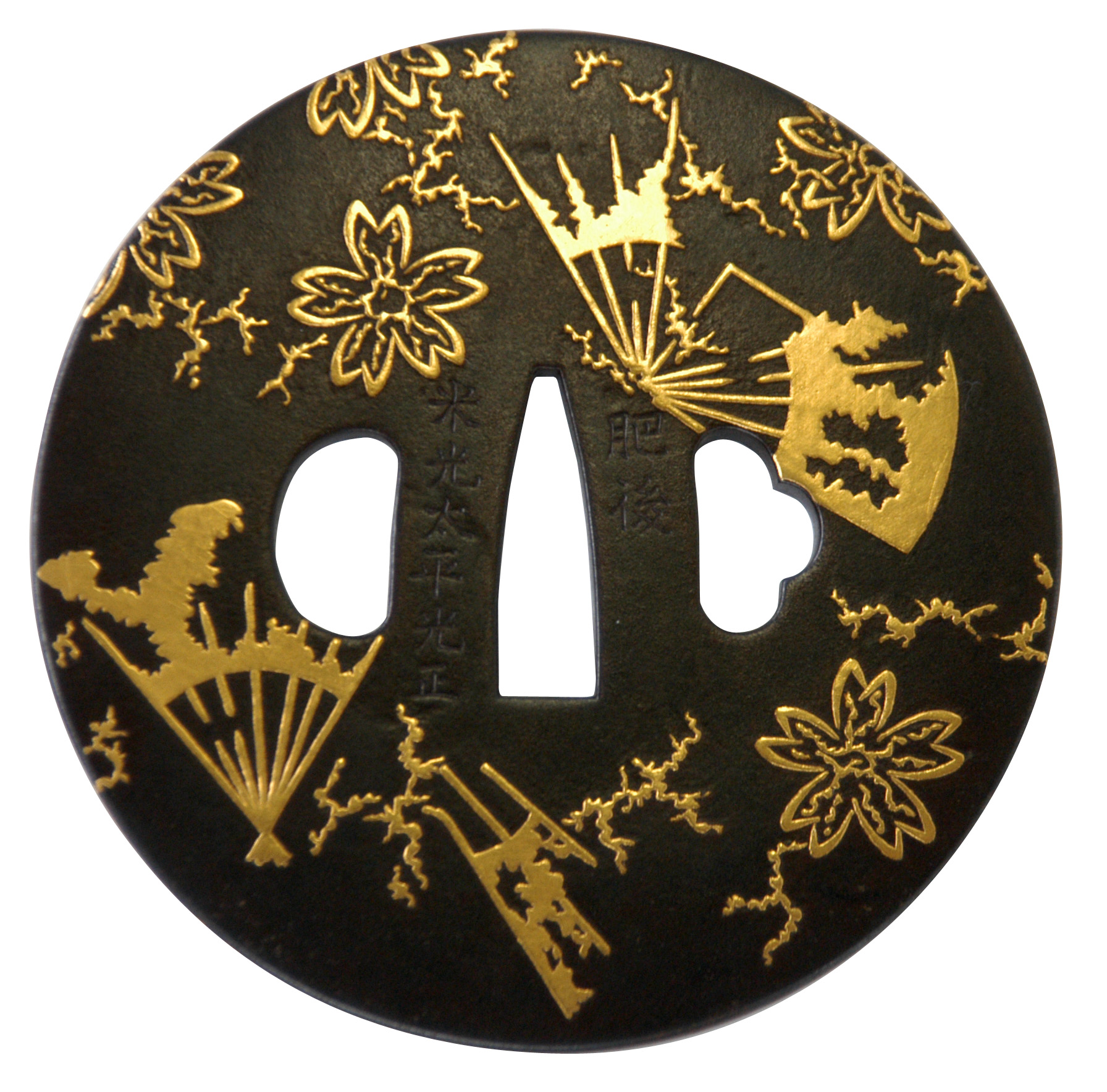肥後象がん/Higo-Zogan
肥後象がんについて

桜破扇象嵌鐔 米光 太平
熊本県の工芸品の代表にあげられる肥後象がんは、地鉄に金銀をはめ込み様々な模様を表現する工芸品です。肥後象がんは、約400年前の江戸時代初期に、鉄砲鍛冶が鉄砲の銃身や刀剣の鐔に装飾として象がんを施したのが始まりといわれています。特に、細川忠興が時の名匠を召し抱えて刀剣金具の製作にあたらせ、技量の奨励をはかったため、鐔や刀装金具類など数多くの名作が産み出され、全国的にも「肥後金工」として高く評価されました。江戸時代の金工には、肥後象がんの始祖といわれる林又七を始めとする林家をはじめ、西垣、平田、志水の4家と幕末の神吉家があげられます。明治維新の廃刀令を受けて刀剣金具の需要が減りましたが、その技術を生かした装身具などが作られるようになりました。昭和には、国の重要無形文化財保持者に認定された米光太平や、県の重要無形文化財に認定された田辺恒雄らにより後継者の育成がなされ、肥後象がんの技術が伝えられています。技法には、布目象がん、彫り込み象がんなどがありますが、現在、多くは布目象がんの技法で製作されています。黒い鉄地の中に金銀の装飾がはめ込まれ、武家文化の伝統を感じさせる重厚感・高い品格が感じられる文具や装身具が作られています。
製造開始年代:江戸以前材料:鉄、金・銀など
肥後象がんの制作工程
About Higo-Zogan

Higo-zogan, or Higo inlay metalwork, is a traditional craft in which gold and silver leaf are used to inlay intricate designs onto an iron base. The production of this craft started with inlay designs being used to decorate gun barrels and sword guards 400 years ago in the early Edo Period. Higo metalworking was renowned across Japan for its high quality throughout the Edo Period.Currently, Higo-zogan techniques are used to inlay gold and silver designs on a black iron base to make pens, jewelry, and other accessories that emanate a deep sense of elegance and refinement.
Higo-Zogan Production Step-by-Step
- A design is sketched onto the iron base in ink.
- A chisel is used to finely carve into the iron base in preparation for inlaying the gold and silver.
- Carved areas are given texture by being carved in four directions ? vertically, horizontally, and diagonally.
- Gold and silver are set into the carved areas using a deer antler. Any carved areas leftover outside of the design are rubbed out and erased.
- The gold and silver surfaces are pounded with a small metal hammer.
- A design is engraved into the gold and silver.
- A corrosive liquid is applied, causing the iron not covered with gold and silver to rust.
The iron base is submerged in a tea solution for 30 minutes. Although the gold and silver design remains unharmed, the tannic acid within the tea reacts with the rusted portion of the iron base to form a film of black iron rust on its surface. This prevents the oxidation of the iron.
工芸家紹介(肥後象がん)/Craftsmen
【肥後象がん】
- 稲田 憲太郎
- [株式会社光助]大住 裕司(雅号:光助)
- 河口 知明(雅号:光秋)
- きのした ようこ
- 坂元 明子(神田 明子)
- 白木 良明
- 津崎 洋子
- 坊田 透
- 松永 淳子
- 麻生 翼
- 曽我 俊作(光友)
【肥後象がん】
- 白木 光虎(故)
- 関 維一(雅号:光輪)(故)
- 東 清次(雅号:光利)(故)